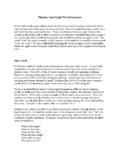Transcription of Methods of Writing Instruction - Teaching As Leadership
1 Methods of Writing Instruction Chapter Seven I. The Basic Building Blocks of Writing II. Instructional Contexts Along a Continuum of Teacher Directedness III. The Writing Process: Pre- Writing , Drafting, Revising, Editing, and Publishing Although we have artificially separated reading and Writing Instruction to clearly explain them both, we must start this chapter by reiterating that reading and Writing are inextricably intertwined skills and processes. We cannot and should not separate the Teaching of reading from the Teaching of Writing . As you will see, the component skills of reading and Writing are most effectively taught in connection with one other. In fact, students achieve the greatest academic gains when their teachers effectively harness the synergy of the reading- Writing partnership. As Marilyn Jager Adams notes, Children's achievements in reading and Writing are quite strongly and positively related an emphasis on Writing activities results in gains in reading achievement.
2 161. Chapter Overview We will approach the subject of Writing Instruction from three, overlapping angles: Part I The Basic Building Blocks of Writing First, we will examine the basic building blocks of Writing , such as spelling, grammar, and handwriting. Students become effective writers more quickly when we teach these fundamental mechanics explicitly and then ask students to put the building blocks into practice by Writing with varying levels of teacher support. Part II Instructional Contexts Along a Continuum of Teacher Directedness In Part II, we will explore a series of the most effective instructional contexts for Writing that fall along a broad continuum of teacher-directedness. As you recall, a fundamental tenet of excellent literacy Instruction is that the teacher leads students toward independence as active readers and writers by providing increasingly less guidance and support over time. While most of us will teach in ways that fall on several places on this continuum on any given day, as a general matter, successful teachers of Writing are those that lead their students toward self-reliance in the Writing process.
3 To that end, we will survey five contexts in which to teach Writing Modeled Writing , Shared Writing , Interactive Writing , Guided Writing , and Independent Writing each method more student-driven than the last. Part III The Writing Process: Pre- Writing , Drafting, Revising, Editing, and Publishing In order for students to write independently, they need to know and be able to use the five-step Writing process: pre- Writing , drafting, revising, editing, and publishing. In Part III of this chapter, we will consider the Writing process itself, looking closely at techniques teachers use to teach the its five steps. Of course, this framework is not meant to be an alternative to (and is not in tension with) the various Methods discussed in Part II. In fact, all of the stages of the Writing process can be taught through Modeled, Shared, Interactive, Guided, and Independent Writing . Adams, Marilyn Jager. Beginning to Read: Thinking and Learning about Print.
4 Cambridge, MA: MIT Press, 1990, p. 161. 375. 125. Methods of Writing Instruction I. The Basic Building Blocks of Writing Reading and Writing are complex, interrelated processes. To read, we break apart a string of letters, decide which sounds those letters represent, and put the sounds back together to determine the word. To spell, we translate the sounds that we hear in speech into written letters. In this way, reading and spelling are opposite but related activities. For this reason, much of the information gleaned in Chapter Three, The Building Blocks of Literacy, will be useful as you guide your students toward Writing proficiency. In this section, we will consider some guidelines for Teaching spelling, grammar, and handwriting. Invented and Conventional Spelling Children proceed through a relatively predictable set of sequential stages in learning to write. They first scribble, and then make linear, repetitive drawings that might resemble cursive in English.
5 Children in this emergent stage may use a few very familiar letters, primarily those contained in their names, to spell all words (you might be surprised that four-year old Dominic would write MDNC for float). Next, children begin to write letters that Spelling and Handwriting? represent beginning and ending sounds in words ( Writing ft for Adults may wince at painful float), and progress to include some consonant blends and vowels childhood memories of penmanship (flot for float). As they understand more of the patterns that lessons and spelling tests. A small influence spelling, children will be able to spell most single syllable but growing number of studies, words with phonetic accuracy (flote for float) but will have difficulty though, suggest that systematically spelling across syllables (confedent for confident). In the final Teaching handwriting and spelling stage, children are able to spell most words correctly, though they might actually help some students may make small errors in the spelling of words containing silent write more and do it better.
6 162. letters or those derived from other languages (inditement for indictment).163. As children are motivated to write, their interest in communicating inevitably outpaces their knowledge of proper spelling. If we accept that students' interest in communicating should take precedence over correct spelling, we are able to ensure that students' interest in communicating does not outpace their ability to write. We simply have to allow young children to write in less conventional ways. Kindergarten through second grade teachers in particular should keep in mind that invented spelling is a critical part of the literacy developmental process. Children who are using invented spelling are demonstrating that they are concentrating on the sound/symbol relationship and then trying to encode it themselves. At first this process doesn't reflect all the patterns that apply to a language (mostly because the student simply hasn't learned them all yet), so a teacher may see many words that are conventionally misspelled, but still reflect a growing knowledge of the sound/symbol relationship.
7 Chrane train dwg dog fesh fish n and There is some controversy about when the transition from invented to conventional spelling should occur. Different students will reach the stage where they are consistently using conventional spelling at different times. Usually by upper elementary, students should not be encouraged to use invented spelling, but rather to use resources to find the correct or standard spelling of words. Viadero, Debra. Studies Back Lessons in Writing , Spelling. Educational Leadership , November 20, 2002. 162. Bear, Donald R. et al. Words Their Way: Words Study for Phonics, Vocabulary, and Spelling Instruction , 3rd Edition. 163. New Jersey: Pearson Prentice Hall, 2004, pp. 11-20. 126. The bottom line is that invented spelling should be encouraged when it signals that students are using their No matter what grade, no matter what level, kids knowledge of sound-symbol correspondences to reach will ask you how to spell whichever word they beyond the spelling patterns they have been taught.
8 We want to use. Teach them spelling strategies (including to just sound it out if they don't have do not want inability to spell a word to stop students from any clue), and then let them make mistakes. If Writing . However, conventional spelling is the ultimate you don't, they'll never become independent goal, and students should be held responsible for spelling writers. Then you can use those mistakes that words and word patterns that they have been taught. they make to guide your Instruction to spelling objectives that they need help with. Guidelines for Teaching Spelling All students benefit from systematic spelling Instruction Shannon Dingle, RGV 03. and practice, and students who are experiencing difficulty in spelling need intensive Instruction and practice tailored to match their individual levels of word knowledge. Strategically select spelling words. Depending on your school's curriculum, you may be handed lists of words that students must learn to spell each week that connect with the broader curriculum.
9 If not, be sure that you select words that include the spelling patterns that you have taught and include words from the curriculum or other content areas. Always begin the year with more frequently used and regular word patterns before moving to less frequently used and less regular patterns. Here are some other general guidelines for spelling Instruction : Review frequently. Improving students' spelling accuracy requires that you review previously taught material often. For example, if you are Teaching your first graders the vowel consonant e spelling pattern, you will ask them to spell words that contain that pattern and some sound- spelling relationships that they learned earlier in the year. When they blend and write kite, they'll be forced to consider why the /k/ sound is spelled with a k and not a c. Revisiting spelling patterns often keeps them fresh in students' minds. For the same reason, it is also useful to provide students with opportunities to analyze and sort words into categories to focus students'.
10 Attention on the spelling and letter patterns that they have already learned. Limit the number of words in one lesson. Expect that students will need to read and work with words many times before they are able to spell them. To give enough practice with each word, do not make your lists too long. Teach students the process of monitoring and checking their spelling. Ask students to double-check their work for spelling and maintain high expectations for correct spelling of previously taught words. Differentiate spelling Instruction . For students who experience spelling difficulty, provide individual or small group Instruction to help them hear the sounds in words and connect those sounds to letters. With a small group of students, you might model how to stretch out a word and segment it into individual sounds, then use spelling cards or phonics charts to prompt students for the correct spelling of those sounds. Students with audioprocessing disorders will struggle to hear the component sounds in a word, so remind them to pay attention to their mouths as they say the word slowly.
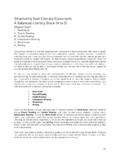
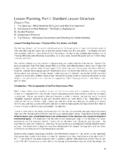
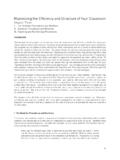
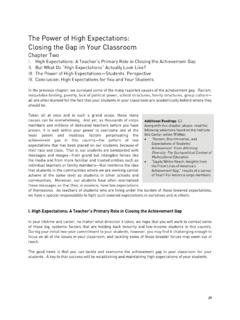
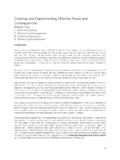
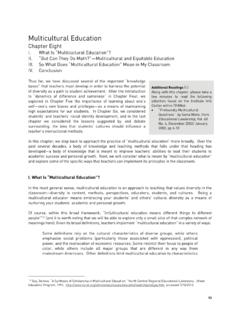
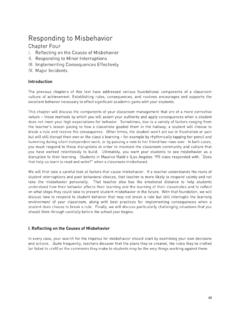
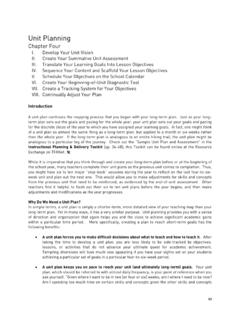

![Boys Section Weekly Agenda [21/1/2018 25/1/2018] Grade 1](/cache/preview/3/c/f/4/e/6/8/4/thumb-3cf4e684011c6a2a6ba82d96c1604014.jpg)
